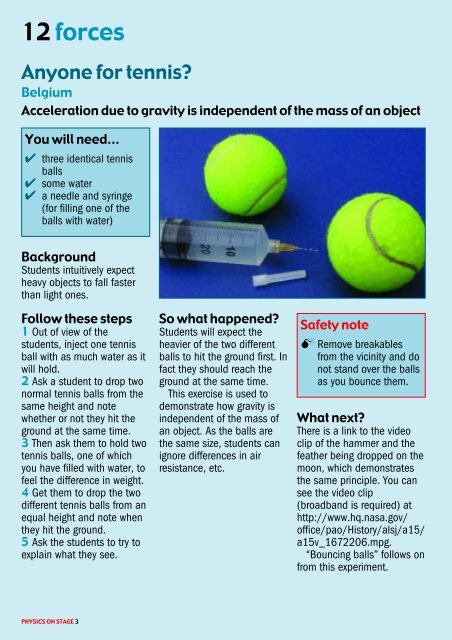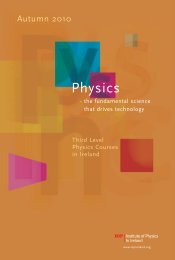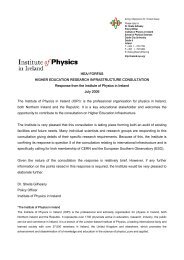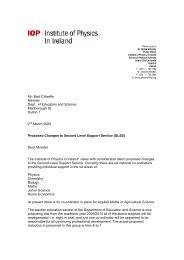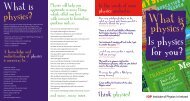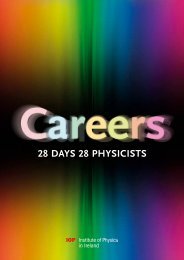PHY ICS - The Institute of Physics in Ireland
PHY ICS - The Institute of Physics in Ireland
PHY ICS - The Institute of Physics in Ireland
Create successful ePaper yourself
Turn your PDF publications into a flip-book with our unique Google optimized e-Paper software.
12 forces<br />
Anyone for tennis?<br />
Belgium<br />
Acceleration due to gravity is <strong>in</strong>dependent <strong>of</strong> the mass <strong>of</strong> an object<br />
You will need...<br />
✔ three identical tennis<br />
balls<br />
✔ some water<br />
✔ a needle and syr<strong>in</strong>ge<br />
(for fill<strong>in</strong>g one <strong>of</strong> the<br />
balls with water)<br />
Background<br />
Students <strong>in</strong>tuitively expect<br />
heavy objects to fall faster<br />
than light ones.<br />
Follow these steps<br />
1 Out <strong>of</strong> view <strong>of</strong> the<br />
students, <strong>in</strong>ject one tennis<br />
ball with as much water as it<br />
will hold.<br />
2 Ask a student to drop two<br />
normal tennis balls from the<br />
same height and note<br />
whether or not they hit the<br />
ground at the same time.<br />
3 <strong>The</strong>n ask them to hold two<br />
tennis balls, one <strong>of</strong> which<br />
you have filled with water, to<br />
feel the difference <strong>in</strong> weight.<br />
4 Get them to drop the two<br />
different tennis balls from an<br />
equal height and note when<br />
they hit the ground.<br />
5 Ask the students to try to<br />
expla<strong>in</strong> what they see.<br />
<strong>PHY</strong>S<strong>ICS</strong> ON STAGE 3<br />
So what happened?<br />
Students will expect the<br />
heavier <strong>of</strong> the two different<br />
balls to hit the ground first. In<br />
fact they should reach the<br />
ground at the same time.<br />
This exercise is used to<br />
demonstrate how gravity is<br />
<strong>in</strong>dependent <strong>of</strong> the mass <strong>of</strong><br />
an object. As the balls are<br />
the same size, students can<br />
ignore differences <strong>in</strong> air<br />
resistance, etc.<br />
Safety note<br />
Remove breakables<br />
from the vic<strong>in</strong>ity and do<br />
not stand over the balls<br />
as you bounce them.<br />
What next?<br />
<strong>The</strong>re is a l<strong>in</strong>k to the video<br />
clip <strong>of</strong> the hammer and the<br />
feather be<strong>in</strong>g dropped on the<br />
moon, which demonstrates<br />
the same pr<strong>in</strong>ciple. You can<br />
see the video clip<br />
(broadband is required) at<br />
http://www.hq.nasa.gov/<br />
<strong>of</strong>fice/pao/History/alsj/a15/<br />
a15v_1672206.mpg.<br />
“Bounc<strong>in</strong>g balls” follows on<br />
from this experiment.


